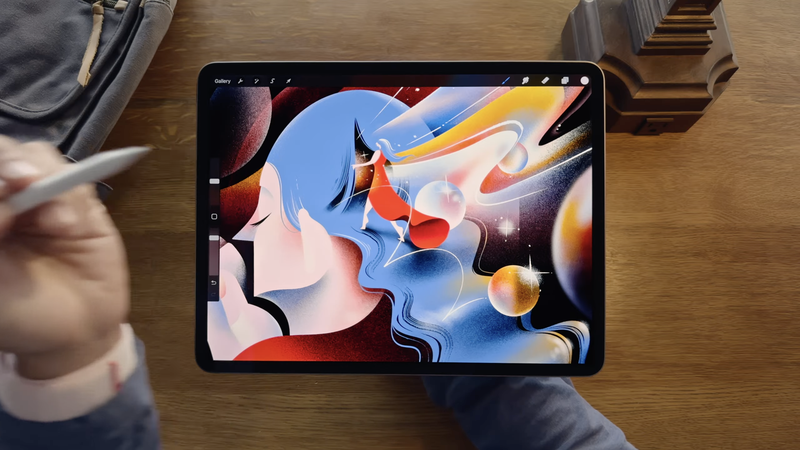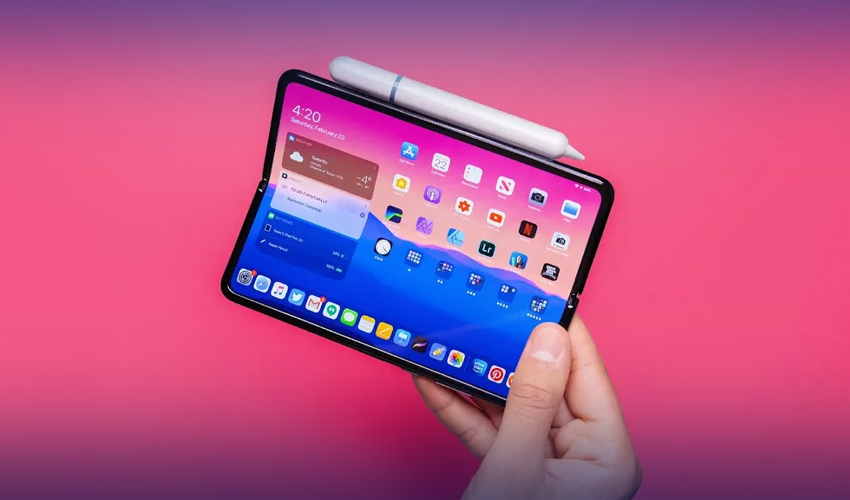iPad and Tablet Innovation: The Future of Portable Computing
In the rapidly advancing world of technology, tablets like the iPad have revolutionized the way we work, create, and interact with digital content. Offering a unique combination of portability, power, and ease of use, the iPad has become one of the most influential devices in the modern tech landscape. But what makes the iPad and other tablets so special, and how have they evolved over time to become indispensable tools for millions of users?
In this article, we’ll dive deep into the world of tablet innovation, focusing on the evolution of the iPad, its features, and what the future holds for these portable computing devices.

The iPad continues to push the boundaries of tablet innovation, offering cutting-edge technology in a portable package.
The Evolution of the iPad
The iPad, first launched by Apple in 2010, was an instant game-changer. While it initially faced skepticism about its necessity in an already crowded market of laptops and smartphones, the iPad quickly established its place by offering the perfect balance of portability and functionality. Over the years, Apple has continuously innovated, refining the device with each iteration.
1. The Early Days: iPad 1 (2010)
When the original iPad debuted, it featured a 9.7-inch display and a single-core processor. While it lacked features like a front camera or multitasking support, it set the stage for the tablet market, demonstrating the potential for touch-based computing in a portable form factor.
2. The iPad 2 and Beyond: Refining the Experience
As Apple introduced the iPad 2, the company improved performance with a dual-core processor, added a front-facing camera, and began to refine the design. This model marked the beginning of iPad’s rise in popularity.
3. The Pro Era: iPad Pro (2015)
The introduction of the iPad Pro in 2015 signaled Apple’s ambition to create a device that could compete directly with laptops. With a larger 12.9-inch display, Apple Pencil compatibility, and the introduction of the Smart Keyboard, the iPad Pro became an ideal tool for creative professionals and those looking for a productivity-focused device.
4. iPad Air and Mini: Versatility at Its Core
Alongside the iPad Pro, Apple continued to offer iPad Air and iPad Mini models, appealing to users looking for more compact and affordable options without sacrificing performance.
Key Features of the iPad and Modern Tablets
The iPad has become synonymous with powerful performance, intuitive design, and versatility. Some of the standout features that make the iPad and tablets in general so compelling include:
1. High-Resolution Display
The iPad Pro features an industry-leading Liquid Retina XDR display, which offers exceptional color accuracy, brightness, and contrast ratios. The stunning display ensures that everything from web browsing to creative work is sharp and vibrant.
2. Apple Pencil Support
For creatives and professionals, Apple Pencil support is one of the standout features. The pencil allows for precise drawing, note-taking, and markup capabilities, turning the iPad into a digital canvas for artists and designers.
3. Multitasking Capabilities
Apple’s multitasking features, like Split View and Slide Over, allow users to run multiple apps simultaneously, making the iPad a powerful device for productivity. This functionality has transformed the iPad into a potential laptop replacement for those who require flexibility.
4. Portability
iPads are ultra-portable devices, allowing users to take their work, entertainment, and creativity on the go. Whether for business meetings, travel, or schoolwork, the iPad’s lightweight design and long battery life make it the perfect companion.

The original iPad’s launch marked a milestone in tablet innovation, spearheaded by Steve Jobs and Apple’s vision.
5. Advanced Performance
With the introduction of Apple’s M1 chip in the iPad Pro, tablets have entered the realm of desktop-class performance. This chip provides unmatched speed and efficiency, making it possible for users to handle demanding tasks like video editing, 3D rendering, and gaming.
Tablet Innovation and the Future of Portable Computing
The future of tablets and iPads is filled with potential. As technology continues to advance, we can expect further innovations in key areas such as display technology, performance, and connectivity. Here are some exciting trends to watch for in the coming years:
1. Foldable Tablets: A New Form Factor
Foldable technology is rapidly gaining traction in the tablet market. Devices like the Samsung Galaxy Z Fold and Microsoft’s Surface Duo have demonstrated the potential of foldable displays. Apple has been rumored to be working on a foldable iPad that could offer a larger screen when unfolded while remaining compact when closed.

Foldable tablets could offer users the best of both worlds: a large screen for work or media and portability for on-the-go use.
2. 5G Connectivity
With the rollout of 5G networks, tablets will become even more powerful, offering faster internet speeds and better performance in remote areas. 5G tablets will allow for faster downloads, seamless video streaming, and improved performance in cloud-based applications.
3. Augmented Reality (AR)
AR technology is poised to be a game-changer for tablets, allowing for immersive experiences in gaming, education, and business. With LiDAR sensors and powerful processors, future iPads may become hubs for AR applications, offering interactive experiences that blend the real and digital worlds.
4. Sustainability and Environmental Impact
As technology evolves, so does the push for sustainability. Apple has been working towards making its products more environmentally friendly, using recycled materials and reducing the carbon footprint of its devices. The future of iPads may involve greener production processes and even more eco-friendly materials.
The iPad vs. Other Tablets: Which Is Right for You?
While the iPad is a leader in the tablet market, there are several other devices worth considering, depending on your needs. Here’s a quick comparison:
iPad vs. Android Tablets
- Operating System: iPads run iPadOS, which is highly optimized for the iPad hardware. Android tablets, on the other hand, run Android, which offers a wider range of customization options but may lack the seamless integration found in iPadOS.
- App Ecosystem: The App Store offers a more polished and consistent experience for iPad users, while Android tablets often rely on a more fragmented app ecosystem.
- Price: iPads generally come at a premium price point, with higher-end models like the iPad Pro offering powerful features. Android tablets, however, offer a broader range of pricing options.
iPad vs. Laptop
- Portability: The iPad is lighter and more compact than most laptops, making it the perfect device for on-the-go use.
- Performance: With the introduction of the M1 chip, iPads are now more capable than ever before, making them a viable option for users who need desktop-like performance without the bulk of a traditional laptop.
- Functionality: Laptops generally provide more ports and the versatility of full desktop software. However, the iPad can handle a wide range of tasks, including email, document editing, media consumption, and even gaming.
FAQs About iPads and Tablets
1. How do I choose between an iPad and an Android tablet?
Choosing between an iPad and an Android tablet largely depends on your budget, preferred operating system, and the apps you plan to use. If you value a seamless, polished experience and top-tier performance, the iPad is likely the better choice. However, if you prefer customization and a more budget-friendly option, Android tablets may be more suitable.
2. Can I use the iPad as a laptop replacement?
Yes, with the introduction of powerful models like the iPad Pro and iPad Air, and accessories like the Magic Keyboard, the iPad can serve as a laptop replacement for many users, especially those focused on tasks like email, document editing, and creative work.
3. What are the benefits of the Apple Pencil for the iPad?
The Apple Pencil is an essential tool for artists, designers, and anyone who requires precision in their work. It enables precise drawing, note-taking, and markup, turning the iPad into a digital canvas and enhancing productivity for creative professionals.
4. How does the iPad compare to traditional laptops for video editing?
While laptops still offer more robust editing software and features, the iPad Pro with its M1 chip and powerful graphics can handle video editing tasks quite well, especially when paired with apps like Final Cut Pro or LumaFusion.
Conclusion: The Future of Tablets is Bright
The iPad and tablet technology have come a long way, and the future looks even brighter. With advances in performance, display technology, and new form factors like foldable devices, tablets are poised to become even more essential in our daily lives. Whether for
work, creativity, or entertainment, the iPad remains a top contender in the tablet space, and with each new release, it continues to push the boundaries of what is possible in portable computing.

The iPad remains at the forefront of tablet innovation, constantly evolving to meet user needs.
Stay tuned as Apple and other tech companies continue to innovate, shaping the future of tablet technology and transforming the way we interact with the digital world.

